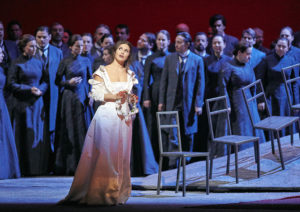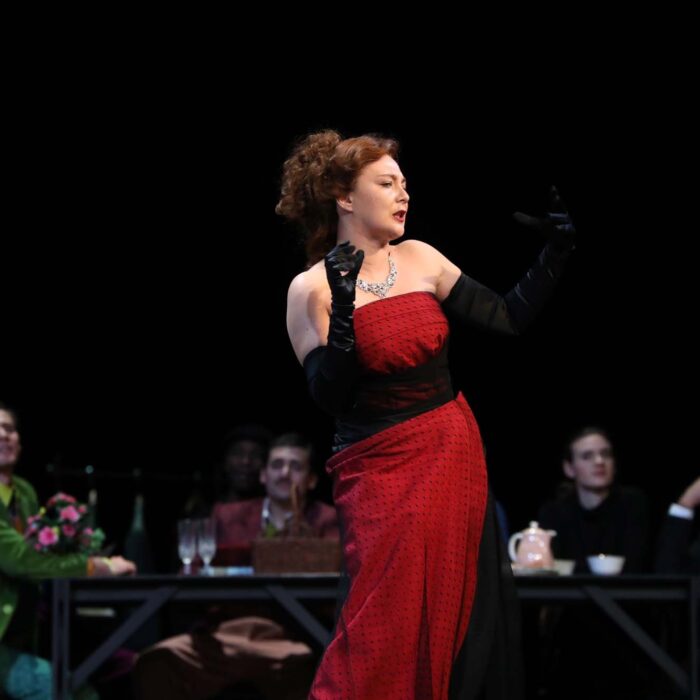
March Madness Part 3: Lucia di Lammermoor’s High F Or Lack Thereof
By Francisco SalazarThere is a perception that if you don’t sing an E flat at the end of the mad scene in “Lucia di Lammermoor,” you don’t have the voice for Donizetti’s virtuoso singing.
But this is a false tradition that has been implanted in opera lover’s minds for too long. I once witnessed an important diva who sang a performance of Lucia without a single E Flat. She had sung the C# s, the Ds throughout the night, but when it came time to sing the climactic note at the end of the mad scene, she chose to omit it. The result was no applause from the audience. Was she wrong not to? Absolutely not.
Why not? After all, if you choose to sing this role, there is an unwritten but inherent understanding with the audience that you won’t cheat them of the hotly anticipated high notes.
The reason is because those were never written in by the composer.
Now I, like most audience members love a great high note to end the night. And in fact, it is exhilarating and chilling. But for so long the Bel canto tradition has been about adding high notes to the end of something to the detriment of the composer’s true intentions.
Now, the purpose of this article is in no way against the final E Flat in “Lucia” or is to criticize the traditions that have been a long part of the opera world. Instead, its purpose is to talk about the real intentions of Donizetti in Lucia’s mad scene.
Lucia’s key
When “Lucia” became part of the repertoire, it was common to cut a number of scenes that did not include the tragic heroine. It also became a common practice for a lighter soprano to begin singing the role. The opera’s keys ended up being transposed down a whole step and the opera sounded like it was all in G Major. But if you listen you pay attention to the original score, each scene is written in a different key, adding to a dramatic structure that influences and describes Lucia’s level of madness.
The opening fountain scene is written in E Flat and A Flat while the duet with Edgardo is written in A. Furthermore the final mad scene is written in F major. Each time, Lucia’s keys go higher adding to her character. That means if you were performing the original keys, a soprano would have to end the famous mad scene with a High F. But because most sopranos don’t have these notes, it was brought down a whole step to accommodate.
And for high note lovers, Donizetti intended for Edgardo to sing an E Flat at the end of the duet between Edgardo and Lucia. But due to singing style and the fact that most lyric tenors today don’t have such notes, the note has almost become extinct from performance practice altogether.
For those interested in seeing the original version of the opera, the French version, which is rarely performed today kept all the keys, but changed Lucia’s opening aria, among a few other things.
Here is Mariella Devia performing the original mad scene with a new cadenza and, yes, she ends with a High F. But how many sopranos actually have these notes?
Now here is Andrea Rost performing the original version with the original cadenza and the original chorus ending that created a more touching, haunting and, in all, more appropriate ending to the first half of the mad scene.
And now I will showcase what most sopranos do today with Anna Netrebko’s E Flat-less performance and Joan Sutherland’s stunning Met showcase.
Hear the difference?
The CADENZA
Now before I conclude this article I want to approach the cadenza which has also become a tradition, but was also never written by Donizetti. When the composer wrote “Lucia: he wrote it with the glass harmonica in mind. The instrument creating an otherworldly sound and haunting tone that was said to produce mental instability. As a result, Donizetti crossed it out of his score. But the instrument was supposed to accompany Lucia in her madness.
Instead, the flute was put in and with it, a cadenza was created, years after Donizetti had died. Most credit Nellie Melba for the virtuosic cadenza which in many ways adds to the madness in the character. However it also distracts from Donizetti’s more somber tone. If you look at the recording with Andrea Rost, you will hear what Donizetti intended. It may lack the excitement and brilliance of the cadenza, but what it does add is more immediacy to the piece.
The Voice Type
Today Lucia is often performed by lighter sopranos. That has reduced the opportunity for more lyric voices to perform the role. But in reality, because the opera was written in a different key, it required lyric voices to perform the work. As Olga Peretyatko noted in an interview with OperaWire, “It was not written with all this stuff. It’s optional. In the score there is no E flat or great fioritura. It’s written for a big voice because the Donizetti orchestra is very strong and you should have a very strong voice. And we are used to seeing a lot of high sopranos with great tops but nothing in the middle.”
If we look at some of the great sopranos of the past, Katia Ricciarelli and Monserrat Caballé performed the work. Both sopranos were not coloraturas but were closer to the voice type that Donizetti was looking for.
Let’s take a look at Katia Ricciarelli’s Mad scene and listen the weight that she gives the music.
Now let’s take a look at Caballé performing the second act duet with Enrico. She has the coloratura runs down and she has the low notes to support Donizetti’s music.
So the next time a soprano decides not to sing an E Flat or omit a high note, we should analyze the choice or the meaning behind it.
Categories
Special Features

